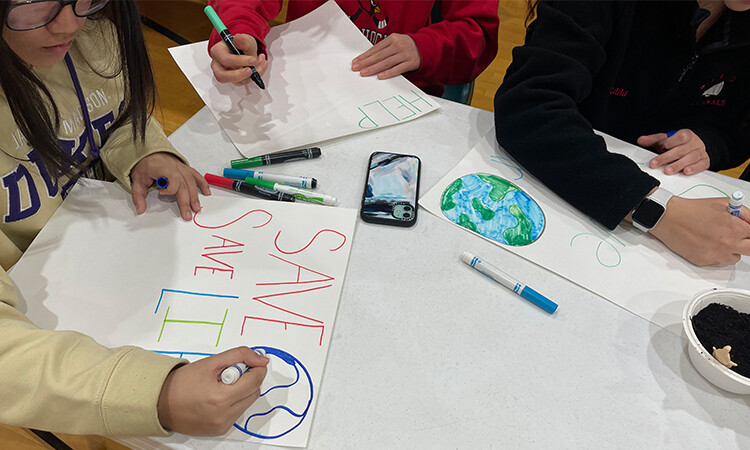Faith and saving the environment: How parishes are inspiring their youth to love God’s creation
At the beginning of his 2015 encyclical, Laudato Si’, Pope Francis calls for an attitude shift: away from the idea that we are masters and consumers of the earth and towards a sense of care and coexistence (11). This involves the entire community, which actively passes down its environmental knowledge and sensitivity from generation to generation. The environment is “on loan to each generation, which must then hand it to the next” (159).
Pope Francis notes that the greatest barrier to environmental education is a culture of “extreme consumerism and affluence, which makes it difficult to develop other habits” (209). The United States, of course, has the largest such culture in the world – and in the seven years since Francis’ writing, that culture has only grown.
So how is the Archdiocese of Newark countering this growing culture, obsessed with the material, which counters the growth of nature? The answer is in the parish community.
When looking at the structure of parishes, Father Timothy Graff, director of Social Concerns for the Archdiocese of Newark, highlights the work that schools, faith formation programs, and youth groups accomplish in fostering intergenerational solidarity. What’s imperative, he says, is that young people have a model for environmental care that they can follow.
“The more that younger people see the Church involved in work with care for creation, the more likely they will see it as a part of their faith experience. Caring for the world that God has entrusted to us brings together this generation’s desire to save the environment and, also, to practice their faith. It can be a perfect match in their eyes.”
This is what Pope Francis hopes for when he calls for an “ecological conversion,” where the effects of one’s encounter with Jesus Christ become evident in their relationship with the world around them (217).
What has become evident is that parishes have taken Francis’ words to heart. Father Graff notes that many have developed Green Teams, which create recycling programs, plant community gardens for local food banks, and promote educational opportunities – among other initiatives. The inclusion of young parishioners in these activities is critical, he says.
At Saint Andrew Church in Westwood, its environmental group, called the Creation Care Team, emphasizes that “youth know they have a voice and that we support and encourage them to take action using their God-given talents,” says Susan Mary Leyden, a team leader. Jessica Giglio, the pastoral associate for teens and communications, adds that the teens of the church are “deeply concerned with environmental issues” and have a “strong conviction to care.”
As Pope Francis puts it: “Young people demand change” (13).
This strong motivation, combined with the church’s encouragement, has seen a rise in participation and creativity from St. Andrew’s youth. Activities have included designing artwork on 1000 reusable bags to be used at the food pantry, creating 3-D environmental posters for Laudato Si’ Week, planting Mary gardens, and environmental-themed trivia games.
Over at Saint Raphael Church in Livingston, its environmental creativity is digital as much as it is physical. The parish developed a Laudato Si’ landing page on its website with many pictures, resources, and opportunities for its parishioners to get involved – including an animated Laudato Si’ video for children.
The pictures incorporate recent events where its youth ministry completed environmental projects to honor Mary. Children planted flowers in the form of rosaries while reciting the rosary, in addition to other plants dedicated to Our Lady of Fatima and St. Francis.
Underneath one of the pictures is a simple but profound message: Everyone, both big and small, can do their part.
In his time, St. Francis asked that a small section of the friary garden be left untouched “so that wild flowers and herbs could grow there, and those who saw them could raise their minds to God, the Creator of such beauty” (12). Similarly, in Laudato Si, Pope Francis asks that we say a small prayer before and after every meal that “reminds us of our dependence on God for life; strengthens our feeling of gratitude for the gifts of creation; acknowledges those who by their labors provide us with these goods; and reaffirms our solidarity with those in greatest need” (227).
As parishes share the love for God’s creation with their youth, it serves as a reminder that no act is too little, no person too unqualified, and no church or group too small to make a positive change for the future of the environment and the future of our children.


at St. Andrew Church




Featured image: Young parishioners of Saint Andrew Church in Westwood design posters during Laudato Si’ Week.


